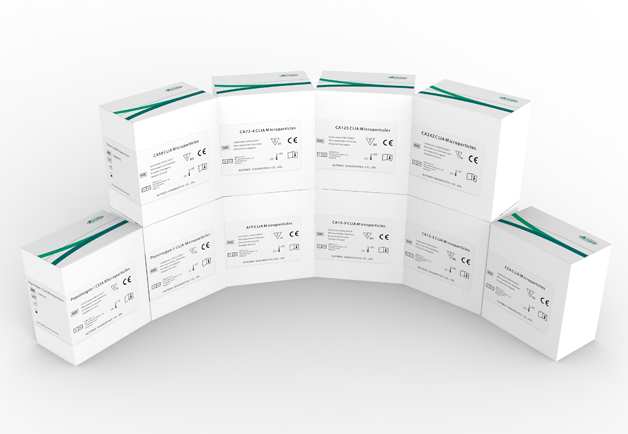

El cáncer gástrico es el cuarto cáncer más frecuente en todo el mundo y es la segunda causa de muerte por cáncer [1]. El cáncer gástrico puede clasificarse generalmente en dos subsitios topográficos, el cardias (parte superior del estómago) y el no cardias (parte inferior del estómago). La infección crónica por Helicobacter pylori se considera la causa principal del cáncer gástrico no cardial, y casi todos los casos se atribuyen a esta bacteria. Por su parte, el cáncer gástrico de cardias se considera vinculado a la infección por H. pylori, al exceso de peso corporal y a la lesión por reflujo gastroesofágico [2].La detección precoz es importante para mejorar la tasa de supervivencia de los pacientes con cáncer gástrico (GC).
Se ha informado de que algunos marcadores tumorales séricos, como el CEA, el CA19-9, el CA50 y el CA72-4, están elevados en algunos pacientes con cáncer gástrico [3-5].
No. de producto | Descripción | Tamaño de paquete | Muestra | Tamaño de muestra | |
CLIA Microparticles CLIA Micropartículas | CMB0102 | AFP | 100T | suero | 25 µL |
CMB0202 | CEA | 100T | suero | 25 µL | |
CMB0402 | CA50 | 100T | suero | 25 µL | |
CMB0802 | CA19-9 | 100T | suero | 25 µL | |
CMB1402 | CA72-4 | 100T | suero | 50 µL |
In advanced or recurrent gastric cancer, the estimation of either CA 19-9 or CA-50 and CEA serum values may help in checking the prognosis, determining the efficacy of palliative treatment modalities, and recognizing recurrences. [12] En el cáncer gástrico avanzado o recurrente, la estimación de los valores séricos de CA 19-9 o CA-50 y CEA puede ayudar a comprobar el pronóstico, determinar la eficacia de las modalidades de tratamiento paliativo y reconocer las recidivas. [12]
CA72-4 es muy sensible al cáncer gástrico, y la tasa de positividad del CA72-4 en suero en el cáncer gástrico es del 36% al 94%. Y su especificidad también es alta, llegando en algunos casos al 100%[13]El CA72-4 puede utilizarse para detectar si hay células tumorales residuales después de la operación y juzgar el pronóstico del cáncer gástrico[14].
[1].Suenaga Y, Kanda M, Ito S, Mochizuki Y, Teramoto H, Ishigure K, Murai T, Asada T, Ishiyama A, Matsushita H, Tanaka C, Kobayashi D, Fujiwara M, Murotani K, Kodera Y. Prognostic significance of perioperative tumor marker levels in stage II/III gastric cancer. World J GastrointestOncol 2019; 11(1): 17-27 [PMID: 30984347 DOI: 10.4251/wjgo.v11.i1.17]
[2] Sung H, Ferlay J, Siegel RL, Laversanne M, Soerjomataram I, Jemal A, Bray F. Global Cancer Statistics 2020: GLOBOCAN Estimates of Incidence and Mortality Worldwide for 36 Cancers in 185 Countries. CA Cancer J Clin. 2021 May;71(3):209-249. doi: 10.3322/caac.21660. Epub 2021 Feb 4. PMID: 33538338.
[3]Ychou M, Duffour J, Kramar A, Gourgou S, Grenier J: Clinical significance and prognostic value of CA 72-4 compared with CEA and CA19-9 in patients with gastric cancer. Dis Markers. 2000, 16: 105-110.
[4]Gao ZL, Zhang C, Du GY, Lu ZJ: Clinical significance of changes in tumor markers, extracellular matrix, MMP-9 and VEGF in patients with gastric carcinoma. Hepatogastroenterology. 2007, 54: 1591-1595.
[5]Adachi Y, Tsuchihashi J, Shiraishi N, Yasuda K, Etoh T, Kitano S: AFP-producing gastric carcinoma: multivariate analysis of prognostic factors in 270 patients. Oncology. 2003, 65: 95-101. 10.1159/000072332.
[6]Hamanaka W, Yoneda S, Shirakusa T, et al: Alpha-fetoprotein (AFP)-producing adrenocortical carcinoma-long survival with various therapeutic strategies including a lung resection: Report of a case. Surg Today. 38:275–278. 2008.
[7]Matsueda K, Yamamoto H, Yoshida Y and Notohara K: Hepatoid carcinoma of the pancreas producing protein induced by vitamin K absence or antagonist II (PIVKA-II) and alpha-fetoprotein (AFP). J Gastroenterol. 41:1011–1019. 2006.
[8]Kinjo T, Taniguchi H, Kushima R, Sekine S, Oda I, Saka M, Gotoda T, Kinjo F, Fujita J and Shimoda T: Histologic and immunohistochemical analyses of α-fetoprotein-producing cancer of the stomach. Am J SurgPathol. 36:56–65. 2012.
[9]Cappetta A, Bergamo F, Mescoli C, Lonardi S, Rugge M and Zagonel V: Hepatoid adenocarcinoma of the colon: What should